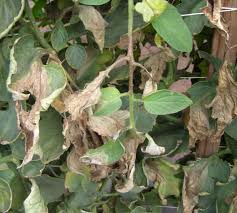Late Blight Disease:

The Central Potato Research Institute (CPRI) recently issued an advisory for potato farmers across the country, warning of a high risk of late blight disease in the crop due to changes in weather conditions.
- Late Blight Disease is one of the most serious fungal diseases that can affect tomatoes and potatoes
- It is spread from infected transplants, volunteer potato or tomato plants, and certain weeds botanically related to tomatoes.
- Spores of this fungus can be airborne and travel great distances in storms. Rain deposits spores on plants, causing infection.
- Late blight is favored by cool, wet weather and will cycle repeatedly if weather conditions are favorable
- When plants have become infected, lesions (round or irregularly shaped areas that range in color from dark green to purplish black and resemble frost injury) appear on the leaves, petioles and stems.
- A whitish growth of spore-producing structures may appear at the margin of the lesions on the under-leaf surfaces.
- Potato tubers develop rot up to 15 mm (0.6 inch) deep.
- Secondary fungi and bacteria(particularly Erwinia species) often invade potato tubers and produce rotting that results in great losses during storage, transit, and marketing.
- The disease can be managed with a timely application of fungicide, though epidemics can occur rapidly once crops are infected.




